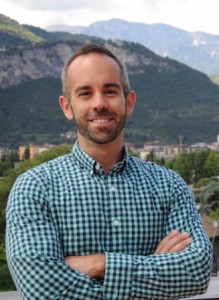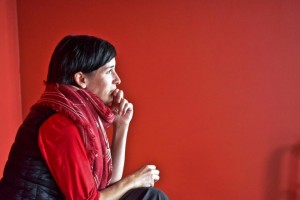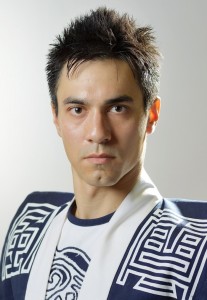|
The Swarthmore College Department of Music and Dance welcomes three new faculty members: Professor James J. Blasina, Professor Stephanie Liapis, and Professor Joe Small.
Professor Blasina is originally from Vancouver, British Columbia, and he has been interested in music since he was a child. His studies with his mentors, Professor Jennifer Bain and Jacqueline War at Dalhousie University, led him to a MA-PhD program at Harvard University, where he wrote his PhD dissertation on the way that music for St. Katherine of Alexandria modeled and mirrored changing conceptions of gender during the 12th and 13th centuries. “In many respects, I see this period as a point of origin for many of the gender systems that have held sway until the twentieth century,” Professor Blasina said. “I see music as an important primary source for illuminating these changes in the ways people were thinking about gender, and on the flip side, looking at music through this particular lens helps us understand [music] better.” Professor Blasina came to know a Swarthmore alum during his time in graduate school. “I was always so impressed by her well-rounded and critical ways of thinking about problems, and by her confidence and willingness to voice her opinions,” Professor Blasina said. “I was so excited when a position was posted in the Music and Dance Department, and I am grateful to be able to contribute to the work of this community of scholars and students.” Last semester, Professor Blasina taught Music 11, a music theory class that focuses on counterpoint, harmony, and musical form. This semester, he is teaching Music 28 (Sound, Sinners, and Saints in Medieval England), a course that considers what sorts of meanings human beings ascribe to sounds and music. He is also teaching Music 1a (1000 Years of Musical Firsts), which focuses on twelve significant musical premiere performances as important artistic and historical moments. Professor Blasina hopes that his students will have two takeaways from his classes. “First of all, in a one-semester course, even on a very focused topic, it’s impossible to cover everything that you’d like to,” Professor Blasina said. Using an analogy from his PhD advisor, Thomas Forrest Kelly, Professor Blasina believes that the big ideas in music history courses are like a row of telephone poles. He and his students will build the “poles” together in the course. “They should be sturdy and will hopefully entice students to fill in the gaps between the poles with ‘wires’ throughout their lives,” Professor Blasina said. The second takeaway is empathy. “It’s too easy to think of people in the distant past with simplifying and dehumanizing tropes,” Professor Blasina said. “But maybe through the classroom experience and by understanding their artistic expressions, we can come to appreciate and feel connected to the human beings—as human beings—who came before us, and by extension, better understand ourselves and our societies.”
Professor Liapis has had a professional career in the performing arts that spans over twenty years. She received a B.F.A. from NYU Tisch School of the Arts and an M.F.A. from the University of Washington. Professor Liapis’s choreographic research focuses on creating and presenting original, collaborative works that often weave in elements of digital sound and video to create a complete visual and sonic experience on stage . Professor Liapis began teaching at Swarthmore College because she was drawn to the diverse dance curriculum offered at the college. “It feels relevant, exciting, and progressive to offer training and education in so many movement forms,” Professor Liapis said. Currently Professor Liapis is teaching Modern dance technique, as well as yoga and dance composition. In these courses, Professor Liapis aims to provide students with opportunities for growth and creative freedom. “In my first semester, I am hoping to build trust with the students,” Professor Liapis said. “I want to provide a safe and exciting learning environment so that the studio becomes an active space for movement experimentation and exploration.” “I have been very impressed with the students’ curiosity and willingness to try,” Professor Liapis continued. “The students at Swarthmore are so motivated and engaged which allows us to really explore our material, it’s origin, it’s path, it’s purpose.” Currently, Professor Liapis is amidst a very exciting time in the dance program. “There is so much energy and momentum that will allow us to be more visible on the Swarthmore campus,” Professor Liapis said. “We are adding courses, developing curriculum, and offering new opportunities for students to work directly with professional choreographers!”
|
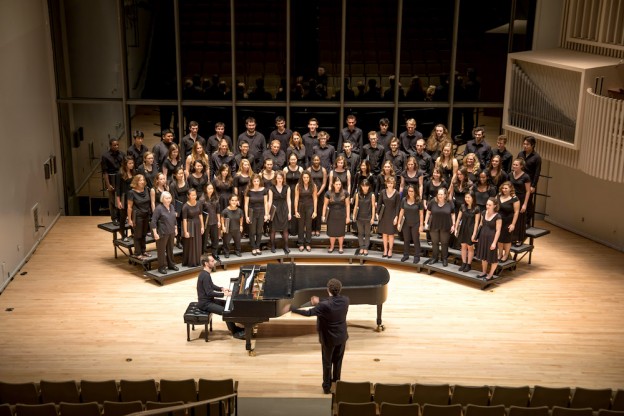
From Boulanger to Bernstein, College Chorus and Garnet Singers Celebrate Centennials
On Saturday, December 8th, at 3:00 pm in the Lang Concert Hall, the Swarthmore College Chorus and Garnet Singers, directed by Joseph Gregorio, will perform their fall concert. The Swarthmore College Chorus is a mixed ensemble comprised mostly of students, but is also open to faculty, staff, and community members. The Garnet Singers is a subset of the Chorus, composed of approximately twenty-four students, focused on works more intimate than those sung by the Chorus.
The Garnet Singers will be performing works in some way connected with the year 1918, and the Chorus will perform pieces by Leonard Bernstein. “1918 turns out to have been a significant year in music history as well as in world history,” Gregorio said.
Gregorio has always wanted to program Bernstein’s Chichester Psalms with the Chorus. Since it is the centenary of Bernstein’s birth, it seemed like the perfect timing to have such a program. In addition to Chichester Psalms, Gregorio chose to incorporate a few songs from West Side Story. “To represent Bernstein’s oeuvre more fully, I thought it would be nice to round out Chorus’s program with a few songs from West Side Story, which has some interesting musical connections toChichester Psalms,” Gregorio said.
Gregorio also notes that coincidentally, 1918 was the year of the death of three magnificent composers: Lili Boulanger, Claude Debussy, and Charles Hubert Hastings Parry. To further explore the theme and significance of 1918, the Garnet Singers will be performing a set that includes one work by each of these composers. Additionally, several other pieces will be included in the performance that have roots in the events of 1918.
This fall concert will also feature an original work by Lili Tobias ‘19. “The ensemble is especially excited to perform the premiere of Tobias’s piece, which Tobias wrote for us as a musical reflection on Lili Boulanger’s song ‘Reflets,’” Gregorio said.
Another student, Deondre Jordan ’19, will conduct the performance of Stephen Chatman’s In Flanders Fields.
Over the last five and a half years, the Chorus has doubled in size, presenting a continual challenge for Gregorio as well as the members of the group. Everyone must adapt to the current size of the group in order to continue making music at a high level. “Both ensembles, along with student pianist Mia Shoquist ’21, have worked tremendously hard to prepare for our December 8 concert,” Gregorio said. “The Garnet Singers have not only put in a great deal of musical work, but have also given generously of their psychological energy to bring to life music that is sometimes emotionally taxing to sing.”
“As ever, I am coming to the end of the semester with immense gratitude toward all of the musicians in our choral ensembles for all they have shared of themselves to make the concert a success,” Gregorio concluded.
David Chan ’19
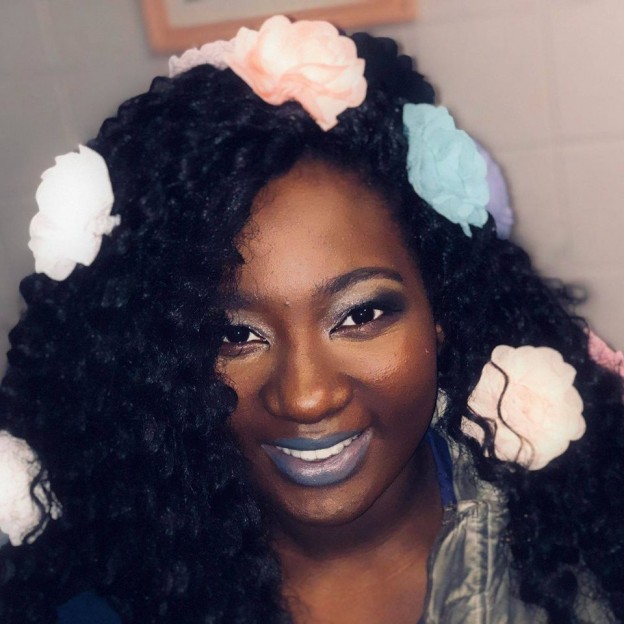
Profile of Dance Major Zara Williams-Nicholas ’19
Zara Williams-Nicholas ‘19 is an international student from Jamaica, majoring in mathematics and dance at Swarthmore College. Williams-Nicholas started dancing when she was living in Jamaica, beginning ballet classes at the age of two. However, after moving to Massachusetts for high school, she was forced to stop taking dance classes due to financial obstacles.
Williams-Nicholas did not initially consider majoring in dance since dance is not usually associated with economic stability. “I was thinking I had to have a major that would help support me financially,” Williams-Nicholas said. “I chose math because the analysis of structures really interested me.”
Remarkably, it was mathematics that led Williams-Nicholas back to her interest in dance. “It was later on that I realized that the analysis of geometric and other structures could be applied to movement creation as well,” Williams-Nicholas said.
In her junior year, Williams-Nicholas took classes in improvisation and contemporary dance. Because of her experiences in those classes, she reconnected with dance and began identifying strongly as a dancer. “I felt as if I had found dance styles that really resonated with me as an artist in contemporary dance class,” Williams-Nicholas said. “As for improvisation, I began using dance as a framework for everyday life, exploring movement practices and creation even outside of class.
Through dance, Williams-Nicholas has been able to challenge herself, especially since she had to complete most of the major in one year. “I sometimes feel physically fatigued, but my love for what I do pushes me forward,” Williams-Nicholas said.
Furthermore, Williams-Nicholas uses dance as a conduit for self-love. “It is an art form that lets you communicate with the world in a way that I personally find very pleasing,” Williams-Nicholas said. “It is also a process wherein you can really begin to love your body for what it can do, and where you can get out of the habit of disliking the look of your body.”
For Williams-Nicholas, dance is not just about mastering the technical aspects—it is also about discovering how your body moves through space. “You become aware of small movements and tendencies in your body that you may not have been aware of beforehand,” Williams-Nicholas said. “You can create movement that is unique to your body and that tells a story that you want to tell.”
“I have learned bodily awareness for myself and for others, and I have learned about the idea of consent while partnering or doing group work,” Williams-Nicholas continued.
Before coming to Swarthmore, Williams-Nicholas choreographed an original piece at her old school in Jamaica. She attributes that performance as one of the happiest times of her life. At Swarthmore, she has choreographed a piece in response to Thomas DeFrantz’s visit to her contemporary dance class. “The piece focused on blackness in dance and how that tends to be received,” Williams-Nicholas said.
Currently, Williams-Nicholas has many projects in progress. For the upcoming Fall Dance Concert, she is working on Professor Stephanie Liapis’s modern dance piece and on Professor LaDeva Davis’s tap dance piece. Additionally, Williams-Nicholas is a part of student dance group Terpsichore, working on a piece about her personal life, which she hopes to reflect through movement. She recently joined Rhythm and Motion, a tri-co student dance group, and is working on various pieces for that group, as well.
After graduation, Williams-Nicholas hopes to continue dancing. “I hope to use both my majors after graduation, doing some combination of problem-solving and movement for the rest of my life” Williams-Nicholas said. “I want to be financially stable, I want the ability to dance onstage and to choreograph, and I want to continue to develop my dance practice in a safe way so that I can dance for as long as possible.”
David Chan ‘19
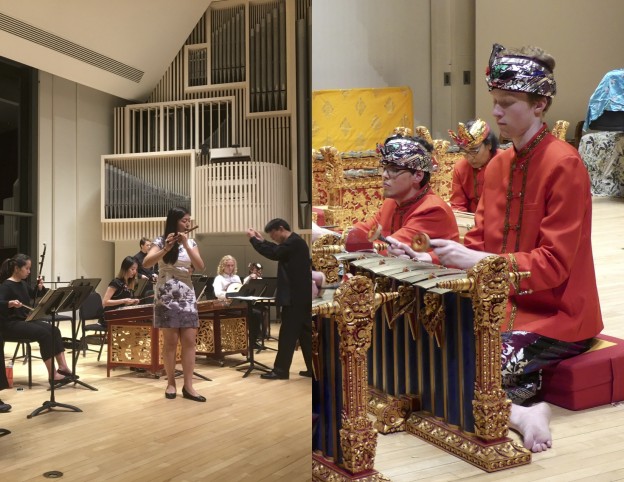
Gamelan and Chinese Music Ensemble Perform in Joint Concert
When asked what they hope students get out of participating in their respective music ensembles, Professors Lei Ouyang Bryant and Tom Whitman both make reference to communal music-making as a way to escape the numerous pressures experienced by a typical Swarthmore student. “I think it is great for Swatties to play music for two to four hours a week amidst the rest of their busy schedules,” says Bryant, co-director of the Chinese Music Ensemble (CME). Whitman, co-director of Gamelan Semara Santi (Gamelan), which plays music from Bali, Indonesia, puts it a bit more bluntly: “It is my hope that students find in Gamelan a place to rid themselves of the stress that is endemic at Swarthmore.”
Beyond just stress relief, though, Bryant and Whitman hope that their respective groups provide space for community members to either explore a different music culture or celebrate and recognize their own. Whitman runs Gamelan rehearsals “Indonesian style—without any notation, and with minimal talking or analysis. I’d like our sessions to create a safe space where students can learn about Balinese culture by doing, rather than by reading or talking.” For her part, Bryant sees the CME “as a valuable site on campus where Asian students, Asian American students, and students interested in Chinese culture can work together and find community with each other.”
Enthusiasm for such a community is evident in the fact that enrollment in CME has more than doubled in its first three semesters. The ensemble is open to all, although most of this semester’s 25 members came in with some musical training. However, few had experience with traditional Chinese instruments such the guzheng (zither), erhu (bowed fiddle), pipa (plucked lute), yangqin (hammered dulcimer) or dizi (flute). Bryant’s co-director Guowei Wang, a Shanghai-born erhu artist, arranges folk songs and more recent Chinese and Taiwanese compositions to tailor them to the specific skill levels and talents of the current crop of students. Bryant describes the CME as “so fortunate to have [Wang] co-directing the ensemble and developing repertoire that everyone, from beginner to advanced, can play within one semester of study.”
Gamelan is also open to students—and Swarthmore community members—regardless of musical background, and is perhaps slightly more accessible to newbies due to the percussive nature of its instruments, which consist of mostly bronze-keyed xylophones, gongs, and drums. But while hitting a gong might as a technical act be a bit easier than playing a fiddle, for example, the overall musical product is quite complicated, with each person playing an essential rhythmic role. Says senior Aly Ye, who has been a part of Gamelan for all of her four years at Swarthmore, “I love the complexity of the music and the challenge of learning it together, part by part, as an ensemble.” The tightly interwoven percussive parts result in a soundscape that is, according to Whitman, a “beautiful texture of different layers.”
Another non-sound layer is sometimes added to the mix when Gamelan pieces are accompanied by dance. Whitman explains that, “in Bali, dance and music are two facets of the same coin,” and that “while there are many pieces of instrumental music that do not accompany dance, all are informed by the spirit and many specific techniques from Balinese dance.” This close relationship has been evident to Ye, who will dance and play in the upcoming show. She says that “because the dance is so closely tied to the music, I feel like I’ve gained deeper insight into why the music moves and changes in the way that it does…. there are many times when something is emphasized in the music that, when I’m learning the dance, suddenly make more sense.” Whitman states that his lack of dance training is “one of my biggest weaknesses as a gamelan director. But we are extremely fortunate that our co-directors, I Nyoman Suadin and Latifah Alsegaf, come to campus. They bring to our ensemble that dimension of dance that I am not competent to teach.”
Audiences can come experience this auditory and visual feast in person on Sunday, December 2nd at 3pm, in the Chinese Music Ensemble and Gamelan Semara Santi’s combined end-of-semester concert. The performance will be held in Lang Concert Hall and is free and open to the public. Families are welcome!
Lydia Roe ’20
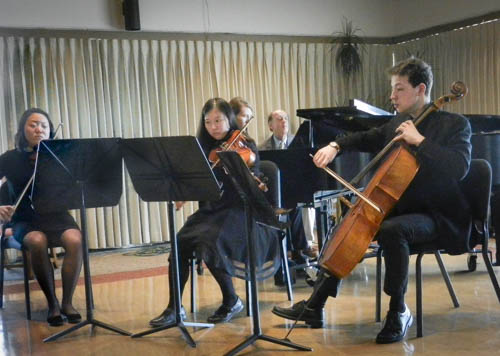
Opera, Jazz, Sonatas, and More Featured in Fetter Concerts
On Friday, November 30th at 8:00 pm in the Lang Concert Hall, the semester’s first concert of the Elizabeth Pollard Fetter Chamber Music Program will be held. The Department of Music and Dance has been supporting the Fetter Chamber Program for four decades, allowing student musicians to receive professional coaching. Students must audition in order to participate in the program. Student musicians are then divided into various groups that meet weekly for ten one-hour coached rehearsals, as well as a weekly one-hour self-directed rehearsal. This consistent rehearsal process culminates in a performance at the end of the semester.
Dr. Michael Johns is the current director of the Fetter Chamber Music Program. His role is to help set up the semester, put the programs together, pair groups with appropriate coaches, and monitor how the groups are progressing. In general, the selection of groups, performing partners, and repertoire are student-generated. “When someone expresses an interest in participating but does not have a partner, I help to build a group,” Dr. Johns said.
Although the Fetter Chamber Music Program was put in place to fund coaching for student musicians, the weekly self-directed rehearsal is what ultimately shapes the performance that the audience will see. “This is an important aspect because chamber music is a conversation among equals and members of the group must develop their own internal dialogue,” Dr. Johns said.
Eleven student groups will perform, including duos for flute/piano, violin/piano, two pianos, piano four-hands, and cello/piano; a piano/violin/cello trio; some late Middle Ages, gospel, and opera vocal selections; a jazz combo and an improvisation group. “As you can see it is an eclectic mix with, literally, something for everyone,” Dr. Johns said. “The concerts will span 700 years of musical history, from improv being conceived in the moment to works from the 14th century.”
This year’s preparation for the concert has been quite different than in previous years because some students expressed interest in mounting an opera.
“Preparing for the preview in this semester’s concert has been particularly unusual because we haven’t actually staged the opera yet,” Rebecca Regan ‘19 said. “We’ve had to be creative and put together a semi-staged performance, which communicates the theatricality of the piece in a way that’s presentable and dramatically effective, even in the absence of full blocking.”
Regan will be one of the six featured sopranos in The Audition, which is a one-act comedic opera conceived by Martha Collins. Collins wrote the libretto and arranged music that was originally composed by Franz von Suppé.
“The Audition is unequivocally an ensemble piece, but nevertheless as an opera it goes back and forth between choruses and solos/duets,” Regan said. “Hence, it required an extra degree of flexibility and independence in making sure to do the work we needed to do on our solo parts while working on the choruses together.”
“One lovely thing about this music — the opening number, ‘Audition Jitters,’ in particular — is that the six parts weave together in a number of different ways and each character interacts musically with multiple others,” Regan continued.
The other two pieces that will be performed in the concert had a more traditional preparation process. Berlin Chen ‘19 will be playing the violin in the Piano Trio in a Minor, which was composed by Joseph Maurice Ravel in 1914.
Piano Trio in a Minor follows the standard plan of a piano trio, with the first and fourth movements in sonata form surrounding a scherzo/trio and slow movement. The piece is dramatic in mood due to the many ebbs and flows, and to its large dynamic range.
“Ravel Trio is a tricky piece to play!” Chen said. “For example, there are places where the piano and the strings have different time signatures, so we had to count carefully to make sure we were playing together.”
“Also, the piece has many delicious chords and has interesting use of harmonics in the strings, so I think the performance will be colorful and refreshing.” Chen continued.
Because each semester’s rehearsals and concerts are all unique, student musicians who participate in the Fetter Chamber Music Program always have a chance to challenge themselves and grow.
“It is incredible to hear the amount of growth and maturation from the beginning of the semester to the performance,” Dr. Johns said. “Everyone, without exception, plays up to or exceeds their individual abilities and the students are justifiably proud of their accomplishment.”
Following the first concert on Friday, November 30th will be two more concerts. The second concert will be held on Sunday, December 2nd at 7:30, and the third will be held on Friday, December 7th at 8:00pm.
David Chan ’19
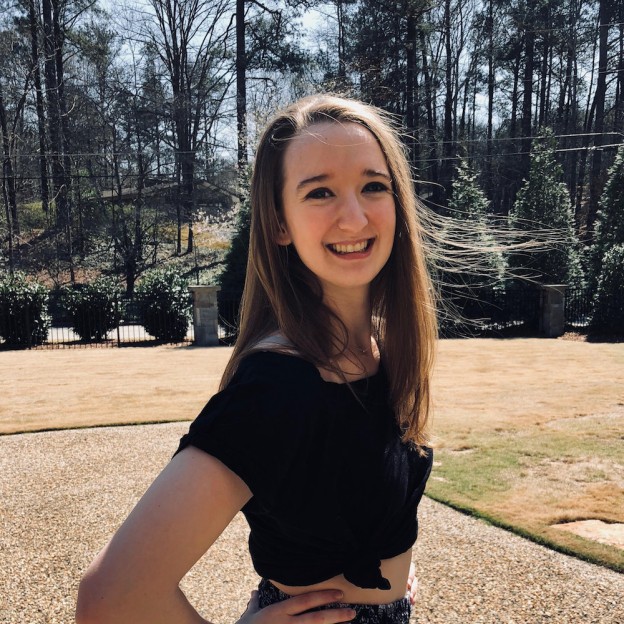
Profile of Dance Minor Ella Small ’19
Ella Small ‘19 is a physics major and dance minor at Swarthmore College. Initially Small did not consider minoring in dance, but she took dance classes at Swarthmore to have fun and to challenge herself.
“I did not think about minoring in dance until this year (my senior year) when I realized how close I was to finishing the minor, just because I kept taking dance classes for fun,” Small said. “I knew coming into Swat my freshman year that I wanted to explore dance, but I never could have guessed how engrossed I’ve become with the sport through the years.”
Prior to Swarthmore, Small did not have a dance background. She only began taking up dance, specifically ballet, to engage herself in a similar activity as gymnastics.“Before coming to Swat, I was a high-level competitive gymnast for 15 years, but I had never actually danced until taking Ballet I here with Professor Olivia Sabee,” Small said.
Because ballet was unfamiliar, Small found the dance form demanding, but ultimately rewarding because she was able to push past her boundaries. “Dance gives me an opportunity to challenge myself physically and mentally,” Small said. “Physically, because it is such a demanding sport, and mentally, because I’m a very shy person, and performing does not come naturally to me. Dance gives me the opportunity to be creative and push myself outside of my comfort zone,” Small continued.
Although Small did not possess previous knowledge about ballet, her transition into Swarthmore ballet classes happened smoothly due to the supportive nature of the Dance Program.“The professors in the Dance [Program] were so encouraging when I first started out, and they kept pushing me to take more challenging courses as I progressed,” Small said. “All of my teachers knew the perfect combination of pushing me to become a better dancer, while encouraging me and reminding me of the progress I’ve made.”
Small identifies one professor in particular whose classes were the most difficult for her. “Every class I take with Professor Chandra Moss-Thorne, I think about how those were [some] of the hardest dance classes I’ve ever taken, and I keep thinking that every week,” Small said.
As Small progressed in her dance classes, she learned much more than just technique. “Working my way from Ballet I to Ballet III and learning to dance en pointe, I’ve discovered so much about dance and performance, and also how my body moves in space,” Small said.
Small even took her dance outside of classes, and she joined the Swarthmore dance group Terpsichore during her sophomore year. By Small’s junior year, she began choreographing original pieces, which were performed in the combined Terpsichore/RnM (Rhythm ‘N Motion, a tri-co dance group) dance concert each semester.
“I remember a bit of a stunned silence after the first piece I choreographed went onstage, because the piece was so intense and unexpected, which encouraged me to keep choreographing for Terpsichore!” Small said.
This semester, Small is choreographing two pieces: a large group piece and an acrobatic piece drawing from her circus and gymnastics background for the upcoming Terpsichore/RnM dance concert on December 15th.
Currently, Small is finishing work for her physics major by taking electrodynamics. She is also amidst graduate school applications, applying to schools that offer a PhD in biomedical engineering. “After Swat, I’m hoping to receive a PhD using both my physics and dance knowledge to study human motion and biomechanics, with the eventual goal of perfecting human-robotic interfaces to help people who have lost mobility through stroke or accident move again,” Small concluded.
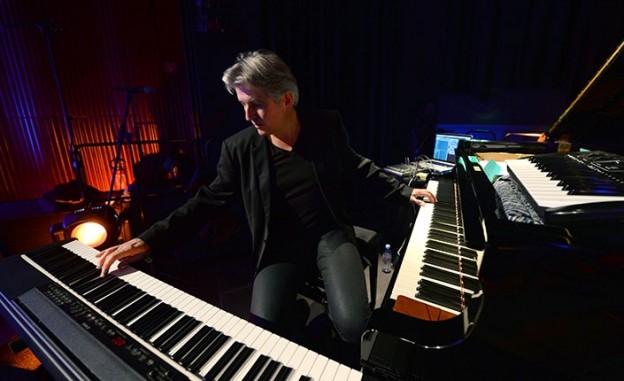
Pianist and Professor Returns to Swarthmore with Music and Monologues
Pianist Hans Lüdemann is returning to Swarthmore College to hold two performances in December. Previously, Lüdemann taught at Swarthmore as a Cornell Visiting Professor during two academic years: 2009-2010 and 2015-2016. In his first year at Swarthmore, Lüdemann taught “Jazz Today” and “African Music,” while in his second year, he taught “Improvisation” and “Jazz History.” One of the reasons why Lüdemann was invited to teach at Swarthmore was his connections to other artists.
“I was able to invite several of the artists I collaborate with to Swarthmore for concerts and workshops such as the TRIO IVOIRE with Aly Keita, singer Chiwoniso, violinist Mark Feldman and the trio ROOMS,” Lüdemann said. “The final performance was a collaboration between the TRIO IVOIRE, saxophonist Andrew Neu, and the College Jazz Ensemble.”
Currently, Lüdemann is not teaching regularly, except for occasional guest lectures and workshops. Instead, he is touring as a solo pianist in China, playing concerts in four cities—Shenzhen, Ruijin, Guangzhou, and Beijing. Furthermore, Lüdemann is associated with an artist with the record labels BMC and Intuition, and with publisher Schott (the original publisher of Beethoven). He is expecting two new releases next year. For 2019-2020, Lüdemann will be very busy working on solo recitals, touring South Africa, and composing an opera to premiere in 2020.
Although Lüdemann is currently stacked with various projects, his main desire in music has never changed. “My main interest always was, and still is, to invent and to create original music and to follow an artistic path of my own,” Lüdemann said. “I have also always been interested in exploring different musical sources and to draw from those sources.”
On Wednesday, December 5th at 12:30pm in Parrish Parlors, the Department of Music and Dance with the Departments of German and Media Studies will present a special lunch hour concert featuring Lüdemann and saxophonist Andrew Neu, who is also director of the Swarthmore College Jazz Ensemble.
Neu is looking forward to reconnecting with Lüdemann and anticipates a spontaneous concert. “We performed together several times during his tenure here, and we always had very natural chemistry,” Neu said. “We haven’t planned what we’re going to do yet, but that’s not unusual for jazz artists.”
For Lüdemann, he does not know what to expect for his upcoming performance because he never performs twice in the same way.
“There will be improvisation with emotional and atmospheric depth and there will be composed pieces and parts that are very melodic and concentrated,” Lüdemann said. “At times the music can be meditative and introspective, in other moments very lively and expressive.”
“It certainly should be an intense, fun, entertaining, and hopefully also moving experience, and the concert will also depend on the communication between artists and public, that plays an essential part in the creative process,” Lüdemann continued.
In addition to the lunch hour concert, Lüdemann will have a performance incorporating Swarthmore student monologues on Thursday, December 6th from 7:00-8:00 pm at Parrish Parlors. This performance originates from a collaborative project between Lüdemann and German writer Antje Ravic-Strubel. “The intention is to develop ideas in a workshop situation that combine the declamation of texts with musical concepts,” Lüdemann said. “It is a new project initiated by German professor Ute Bettray, and I am very curious myself if it will evolve into something very precise and composed, or if the formats we develop will be more of an improvised nature.”
“I always found that Swarthmore was an inspiring place to be, and a great place to develop and sharpen one’s senses and skills, while being embedded in a very cooperative and social environment. I hope Swarthmore still is and will continue to be this kind of a place, and I am glad to become part of that again, even if it is just for some days this time,” Lüdemann concluded.
David Chan ’19
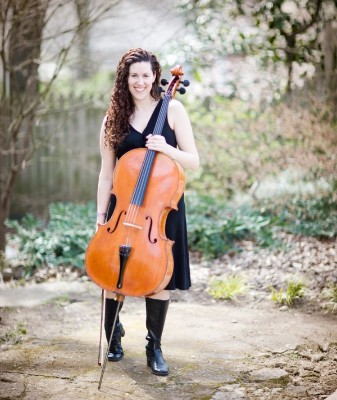
Orchestra Features Amy Barston in Upcoming Concert
As the end of the fall semester approaches, the Swarthmore College Orchestra is preparing for its fall concert, featuring renowned cellist Amy Barston. Barston is one of the Department of Music and Dance’s Featured Artists for the 2018-19 year.
Barston is an incredible musician who has played as a soloist with a number of prestigious orchestras, including a performance with the Chicago Symphony Orchestra at the age of seventeen. She’s also a Juilliard graduate and a cello teacher for the Juilliard Pre-College program, and held a master class for musicians at Swarthmore earlier this month.
The Swarthmore College Orchestra will be playing the Dvorak Cello Concerto with Barston. “When Amy Barston agreed to be one of our Featured Artists this season, we started to talk about what concerto she might play with the orchestra,” recounts orchestra director Andrew Hauze ‘04. “The Dvorak was at the top of both of our lists: not only is it an exquisitely beautiful piece, but it is really symphonic in conception, with a breadth and variety in the instrumental writing that shows Dvorak at his most orchestrally inventive.”
Dvorak was noted to have been originally reluctant to write a concerto for cello, arguing that the cello’s range was utterly unsuited for solo playing with orchestral accompaniment. However, it is now hailed as perhaps one of the greatest concertos of all time, full of beautiful melodic interplay and compelling themes.
Hauze explained his thought process for why he found the Dvorak particularly well-suited for the Swarthmore College Orchestra.
“In an academic setting it’s always best if we can find concerti that will be fulfilling for the orchestra to rehearse alone (without the soloist) for most of the semester, and, in my opinion, the Dvorak has one of the most interesting orchestral parts of any concerto in the standard repertoire. The first movement is on a grand and dramatic scale; the second movement is almost like a wind serenade, filled with prayers, laments, tender beauty, and a funeral march; and the last movement seems to evoke Dvorak’s Slavonic Dances, eventually melting into a ‘long goodbye’ when Dvorak lands in B Major and seems to just want to linger, finding new and ever more beautiful ways to reaffirm our ‘home’ key.”
The other feature for the fall concert is Schumann’s Symphony no. 3. However, this was not the original plan for the fall semester.
“For most of the summer I had planned to pair the Franck D Minor Symphony with the Dvorak concerto,” said Hauze. “I was all set to program it until we had some changes in our personnel: fewer low brass players and not quite as many woodwinds, but lots of new string players! The Franck was no longer as good a fit for our instrumental makeup, and so I decided just before our first rehearsal to substitute Schumann’s Third Symphony.”
Schumann’s Third is a personal favorite of his. “It has magnificent passages for each section of the orchestra. It is also a tremendously life affirming piece and, despite being at times very tiring for the orchestra (as Schumann loves for lots of people to be playing at once), its extraordinary energy and variety of moods make it a deeply satisfying musical experience for player and listener alike. I particularly love the solemn and somewhat creepy fourth movement (a memory of a religious procession outside the majestic Köln Cathedral) that is answered by a jolly and bubbling Finale.”
The Swarthmore College Orchestra’s fall concert is December 1st, at 8:00 pm in Lang Concert Hall.
Andy Zhang ’22
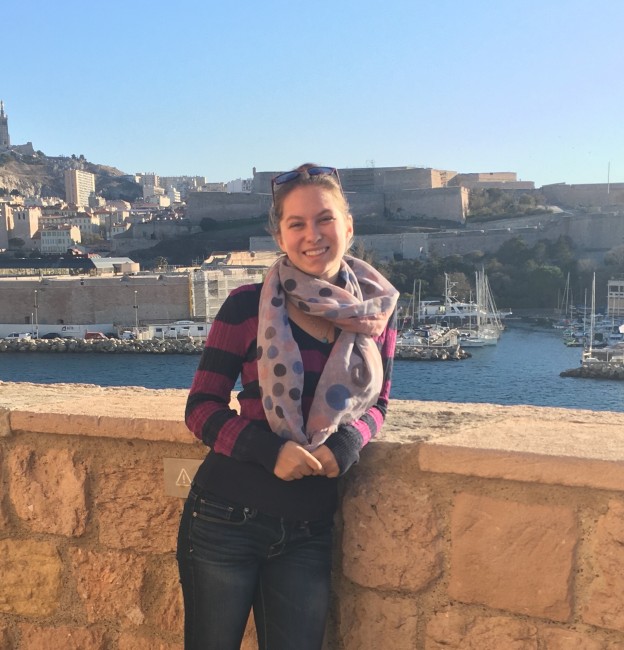
Profile of Dance Major Rachel Isaacs-Falbel ’19
Rachel Isaacs-Falbel, a senior Dance and Anthropology special major, describes herself as “very much a planner.” Her ultimate career goal has been consistent since high school; she wants to be executive director of a dance company someday.
Isaacs-Falbel has a long relationship with dance. When she was a young kid, ballet was offered as a consolation after her mom refused previous requests for figure skating or gymnastics lessons. It ended up sticking, in large part because she loved being onstage, describing herself as “a huge ham, and a huge drama queen.” It wasn’t until junior year of high school that she began to really enjoy ballet not only as an avenue through which to perform but also as a technique itself. Her appreciation of regular ballet classes deepened as she embraced the practice “as a learning process within [herself],” and not just to achieve an external goal.
And then, she says, “when I came to Swarthmore and became part of the dance department, that’s when it all really hit me.” Even more so than in high school, studying ballet and other dance forms proved to be a continuous challenge and avenue for personal growth, as teachers and other students here pushed her to be technically better than she ever thought she could be. “If someone had told me arriving at this school that I would have the control and technique that I have now,” says Isaacs-Falbel, “I would have been like, ‘you are lying, and I can’t do that.’”
But although she was taking technique classes and had “always sort of thought about majoring in dance,” she didn’t seriously consider it as an academic focus until enrolling in The Arts and Social Change with now-retired Professor Sharon E. Friedler. Having previously thought that studying movement theoretically would be boring, Isaacs-Falbel found that in fact the class “was amazing, and it changed my life.” She continued with Dance and Diaspora, taught by Professor Pallabi Chakravorty, which “touched on the interest I’ve always had in other cultures and learning about the world and the way that people interact. I saw that I could do that through studying dance.” After a heart-to-heart with professor and mentor Olivia Sabee in her sophomore year, she decided to combine her interests via a special major in Dance and Anthropology.
It’s proven to be a fruitful choice. Since then, Isaacs-Falbel has studied dance technique and theory abroad in Nice, France, interned at Boston Ballet School, and is currently at work on her thesis, which focuses on diversity initiatives in pre-professional ballet programs. Ballet companies are overwhelmingly white, and, she explains, “one of the main things that [they] say when they’re asked about this lack of representation is that they just can’t find good dancers. So it’s important to look at what the schools are doing.” Although she hasn’t finished her research, Isaacs-Falbel suspects that those schools’ efforts aren’t as sincere as they could be and is exploring in part the “idea of diversity as a commodity” and “the way the term has sort of lost all of its civil rights meanings and has been rearticulated to just mean ‘there’s some black people there,’ not that any structural change has been made.”
While she jokes that someday such a critical analysis will automatically disqualify her “from all the jobs I’ve ever wanted,” she plans to stay immersed in academia for a few more years at least, with the hope of going directly to graduate school for dance studies in France. There, she’ll continue on the trajectory launched by Swarthmore’s program, using dance as a lens through which to investigate both herself and the broader world.
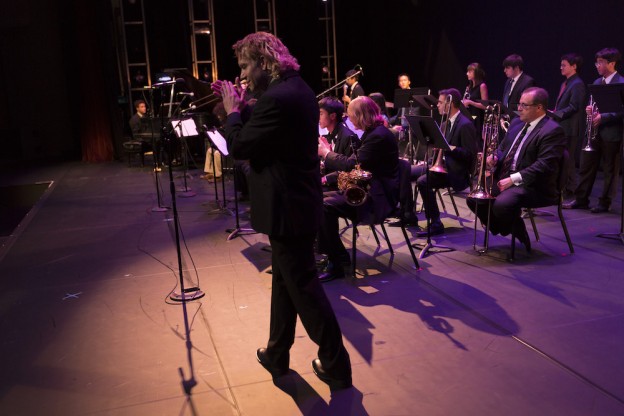
From Copland to War, Swarthmore Students are Jazzing it Up
On Sunday, November 18, Swarthmore College’s Jazz Ensemble and Jazz Combo will perform various music from famous composers like trumpeter Clifford Brown, the band War, pianist and organist Count Basie, Aaron Copland, pianist George Gershwin, and Henry Mancini. It is the wish of Andrew Neu, director of the Jazz Ensemble and one of the college’s Associates in Performance, that the concert will showcase “jazz standards” (like music by Clifford Brown) and music from “legendary big bands” (like music by Count Basie and War) while also highlighting the musical “strength and personality of the band.”
This concert is particularly unique because two of the pieces that will be performed include vocals to be sung by Swarthmore students, a rare occurrence according to Neu. The students who will be singing are Veronica Yabloko, Shelby Billups, Ben Warren, and Omar Camps-Kamrin.
Billups says she is “ immensely excited to not only be singing in a quartet with other talented singers, but to be singing alongside such a large band. This will be my first time singing jazz with a full band and in such a large setting, and I’m so lucky to get to do this with such a talented group of musicians.” Warren also expresses similar enthusiasm, excited for this “ rare opportunity to get to perform with a big band.” He says, “The voice program here [Swarthmore] deals mostly with classical music, and while I love it, it’s always nice to broaden my horizons as a performer.”
In addition to jazz standards and classics like “I’ll Remember Clifford,” “Come Rain or Come Shine,” and “Basie Straight Ahead,” the ensemble will also perform “TSC Blues,” “Fanfare for the Common Man,” “The World is a Ghetto,” pieces that were written “written exclusively for jazz ensembles.” “TSC Blues” is an original composed by Brain Pastor, a Philly locale and principal trombonist of the Philly Pops. “Fanfare for the Common Man,” arranged by Aaron Copland, is a creative, somewhat “unusual” interpretation of music originally purposed for brass and percussion. “The World is a Ghetto” is Andrew Neu’s own arrangement, which, he feels is “nothing like the original.” While the original music leans more towards being R&B, Neu’s arrangement is more “idiomatic towards a jazz ensemble,” almost resembling a jazz waltz.
The full program lineup is: “Basie Straight Ahead,” “TSC Blues,” “I Remember Clifford,” “They Can’t Take That Away From Me,” “Love Beams,” “And What if I Don’t,” “Look to the Sky,” “Fanfare for the Common Man,” “Come Rain or Shine,” “Dreamsville,” “Riverscape,” and “the World is a Ghetto.” “And What if I Don’t” and “Look to the Sky” will be performed by the Jazz Combo, a separate and smaller ensemble of students supported by the Elizabeth Pollard Fetter Chamber Music Program, and the pieces that will include vocals are “They Can’t Take That Away from Me” and “Come Rain or Shine.”
The event will start at 7:30 P.M. in the Lang Concert Hall, and it will be live streamed.
Maria Consuelo de Dios ’21
